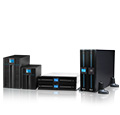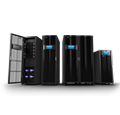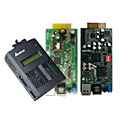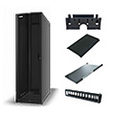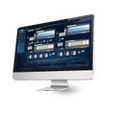產品列表
Modular Data Centers: System Architecture and Benefits
Composition of a modular data center
A modular data center is comprised of the power system, cooling system, rack system, cable connecting system, intelligent management system, and airflow organization and management system.
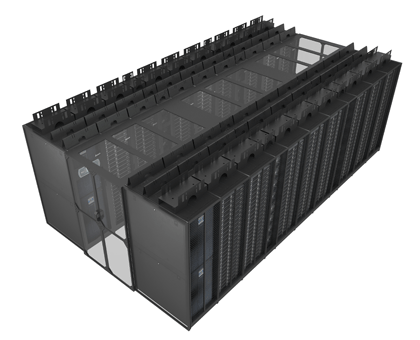
▲Delta modular data center
Power management system
The power management system includes the uninterruptible power supply system (input/output power distribution, UPS unit, PDC), power distribution system for racks, battery system, grounding system, distribution protection system with lightning and surge protection and protective breakers at different levels, and system management. Power management systems of AC and DC distribution are available to customers.
Cooling system
The system includes all sub-systems needed for air conditioning and operations such as a duct system, and cool air distribution equipment at all duct and rack levels. To ensure cooling requirements for the high density racks and reduce the energy waste of refrigeration, in-row cooling units can be used to supply air directly and reduce the loss of cool air. The density of single racks can be increased by up to more than 20kW. The cooling units can be adopted with a direct expansion or chilled water cooling system.
Rack system
The rack is the support mechanism and distribution unit of the IT equipment. It provides a micro-environment for the IT equipment that contains the physical structure, load-bearing, installation and compatibility of the IT equipment, thermal management (air inlet, outlet, airflow management), power distribution (dual power supply, rack mountable PDC), cable management (power and data cables), and others.
Cable connection system
All data cables and power cables are part of the modular data center infrastructure. The methods for laying and management of the cables have a direct effect on the stability of the IT system. As practical experience shows, the reparability and manageability of the cables are among the challenges encountered in the data center in terms of their laying and management.
Intelligent management system
To ensure reliable operation of all sub-systems in modular data centers, an automated monitoring system must be available to supervise and manage them. Required management systems include the power equipment management system, network hardware management system, environment management system, security system and other monitoring hardware and software systems.
Airflow organization and management system
An independent cooling system is used in the modular data center to meet the cooling requirements in all areas. Modular datacenters deploy hot and cold aisles and use in-row cooling units. Blind panels are mounted in the space of the rack where no servers are mounted and 95% of the cold air can be directly delivered to the cold aisles so it enters the server racks. The hot air discharged by all racks is drawn back by the cooling unit so that it will not flow to the front of the rack. The cold or hot aisle containment system in the modular data center can increase the utilization rate of the air conditioning to save energy and reduce consumption. A partially opened fan is mounted on top of the modular data center. It provides an open area of more than 60% of the top of the cold aisle. A gas extinguishing system is installed in the data center. When a fire occurs, the fan on the top of the cold channel opens partially and the magnetic door sensor on the glass door at the end of the cold aisle loses the power to activate the extinguishing of the fire. The modular data center’s inter-connected system for firefighting is controlled automatically and a status signal is sent to the fire center. The fan on top of the cold aisle is then opened partially and automatically via a signal from the fire control center. The airflow organization and management system is comprised of the skylight system, side-door system and control system.
Advantages of modular data centers
-
Reduced human error
Modular components reduce human error in the data center. All operations from assembly of the modules to the troubleshooting of the system, documentation and training are easier and more effective, ensuring the proficiency of the employees and preventing errors. -
Prediction of problems
The working principles and the standardized programs for modular data centers such as equipment monitoring and predictive maintenance programs form a powerful defense mechanism against “unexpected” incidents. -
Improved efficiency
Efficiency is improved as the learning effect spreads and is promoted among employees. More knowledgeable employees are better at solving problems. Reducing human error also reduces the time needed for problem solving including answering troubleshooting calls on hot lines. This releases human resources, which can be used more efficiently. -
Advantages of batch production
Standardization of parts and processes makes the batch production of modular data centers possible. Batch production has the advantages of lower costs, higher quality, easier repair and shorter lead time. -
Expandability of modular data centers
A modular data center can be deployed depending on current IT requirements and can be expanded in the future, if needed. TCO is reduced significantly as a result. -
Flexibility of the modular system
When a modular data center is installed, upgraded and reconfigured, the independent components, standard interfaces and comprehensive structures save both time and cost. -
Reduction of failure repair time
The flexibility and plug-in characteristics of the modular data center allows many operations to be completed in the factory before delivery, such as pre-cabling of the distribution equipment, as well as after delivery, such as the repair of a power module. Statistically, the failure rate of operations carried out in the factory is much less than operations carried out at the site. Compared with a UPS power module repaired at the site, the probability that a module repaired in the factory brings about a power or other failure or cannot recover its full-load capability is hundreds of times less.
Delta modular data center solutions
Delta’s solutions include the mains distribution cabinet, PDC (power distribution cabinet), battery cabinet, network cabinet, in-row cooling, aisle containment components, environment management system, access control, video surveillance, base and internal wiring bridge. They are planned as follows:
|
Table 1: Planning for Delta modular data center products
Advantages of Delta modular data center solutions
-
Modular data centers adopt a top wiring system and the indoor cabling rack is mounted on top of the modular racks. High and low voltage power are separated.
-
The power distribution cabinets provide the power supply for network cabinets.
The battery pack can be installed in the battery room. -
Modular data centers are supervised with or without a color touch panel assigned to each module. Upload of information is executed via a touch panel in the former case, or DAM in the latter case.
-
Modular data centers are equipped with Class B and C lightning protection systems.
-
The touch panel (optional) shows information about the PDC, precision cooling, power distribution cabinets, the environment in the racks, water leakage, temperature, humidity, smoke detection, door status, and more.
-
The UPS and precision cooling are the same in shape, size and color. All cabinets have a one-piece structure.
-
All UPS, precision cooling, and monitoring systems are developed by Delta. Core technologies and know-how are in the hands of Delta’s R&D center.
-
The power supply systems of the small and medium modular data centers are integrated in a cabinet to conserve space for key IT devices.

▲Delta InfraSuite Solutions have helped a smart city project in the Far East, build a modular data center.




